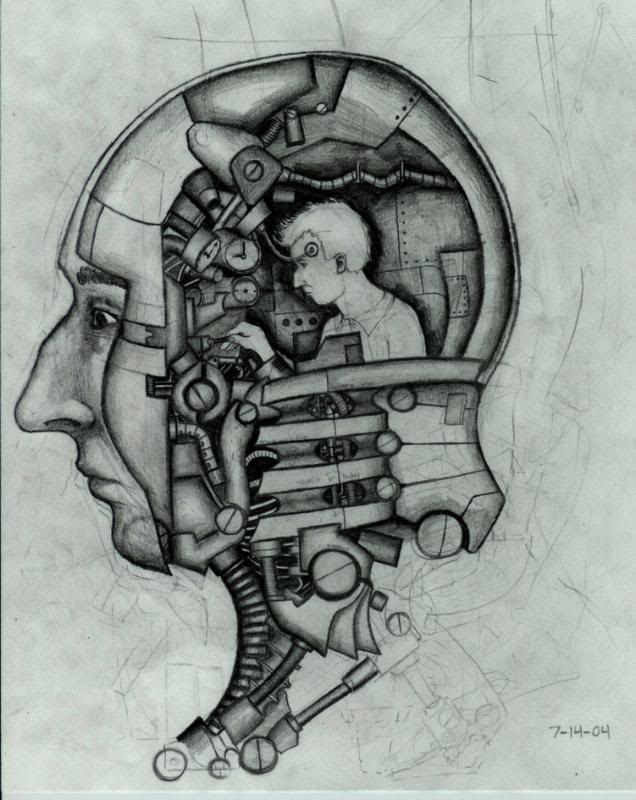Notes on a talk by Matthew Remski at Centre of Gravity, Toronto, Dec. 11, 2012
Intro by Michael Stone
Matthew is always someone who goes too far. For instance, he had the idea to start a yoga fest, and it had to happen in the most beautiful building in the city, featuring local talent who could never present twice without corporate schlock ads to pay for it. In his approach to Patanjali he has not simply produced a commentary, like many others before him, but a complete remix. Matthew’s deep digs have made him a lightning rod for critique and debate, and it’s a pleasure to welcome him here to the Centre of Gravity.
Matthew
Let me begin with a couple of excerpts from my new book threads of yoga: a remix of patanjali’s yoga sutras.
The legacy of yoga has been resurrected in our time through the innate pleasure of our flesh. The simplest techniques of breathing, spinal elongation, and joint fluidity have given countless body-alienated postmoderns a renewed sense of vitality, purpose, grounding, and connection. As technology changes the body — in some ways to the point of ubiquity or uselessness — the meme of modern postural yoga has called out our tissues into the daylight. And although there is surely spectacle involved, evoking complicated feelings about how the flesh should look or move, most practitioners know that yoga’s real gift is that of internal sensitivity. In modern yoga we are given a physical culture that rewrites the meaning of flesh from the inside out. If the breath isn’t relaxed, we know we’re not quite there. If thought has not stilled and focussed into the waves of present sensation, we know there’s more (or less) work to do. Further: if the pleasure of musculo-skeletal alignment and warmed circulation does not somehow sweeten our interpersonal relationships, lend resilient courage to daily life, and inspire us towards social and ecological justice, we know we’re missing something. Through modern postural yoga we have remembered that our flesh innately wants to rejoice, connect and serve, and that it does not lie.
This yoga renaissance is quietly rewriting a central theme of its parent tradition. The body has rarely if ever been considered as its own value in older yoga cultures. At best, the body has been seen as a vessel for an unseen higher essence, and therefore an instrument for its own transcendence, as per the many tantric and natha yoga lineages. Less positively, the body has been seen as the definitive proof of separation from divinity, as in the bhakti yoga lineages. And perhaps the most negative view of all — the body as the repulsive devolution of consciousness and an obstacle to the recovery of self-knowledge — has been the hallmark of many ascetic views that in no way reflect our present values, yet echo stubbornly through our discourse and unspoken sentiments. The yoga sutras of Patanjali fall squarely into this ascetic mood: compiled from the sayings of renunciates of many stripes who at the dawn of urbanization fled their families and social roles to tiny forest ashrams, where, with great austerities, they attempted to tame the unruly and desirous body towards the goal of transcendent epiphany.
Patanjali says little about the value of embodied sensation. He says little about interpersonal love, and nothing of children or ecology. He presents an ultimately internalizing path, in which ethics are a means towards social disentanglement, and the body has evolutionary value to the extent we are disgusted by it (sutra 2.40). In other words, he teaches exactly against the present zeitgeist of yoga culture. And yet his book is presented, largely uncritically, as a seminal text in most yoga education programmes throughout the world today. Our dogged adherence to it is either a sign of nostalgia for a bygone age, or, more problematically, a hidden wish to console our complex interpersonal suffering through social withdrawal and meditative narcissism — which some might say we’re already accomplishing through consumerism.
But we are also powerfully enthralled by Patanjali’s unwavering examination of conscious and unconscious processes. There is something mystically attractive about an Axial Age description of thought and psychological patterning presented with such quiet authority. My experience is that many who encounter the aphorisms have the immediate sense that they arise out of a non-distractedness that our world and culture can rarely offer. They suspend us in a mood of extended contemplation and confident stillness. One of the primary attractions of the text, regardless of the philosophy it presents, is that it highlights the relative crudeness of our speed, our data-saturation, our ambivalence, our vulnerability to alienation and the banal. And in a world of limitless copy, the economy of these aphorisms shines like the edge of a blade.
It is this close and precise attention that I wish to translate here, if not the metaphysics. Philosophy will change through discourse: all tenets are temporary and unstable. What does not change is the requirement of attention that makes our changing discourse evolutionary, as opposed to supplementary. I offer this text and commentary as an alternative speculation on what Patanjali’s attention and incision might offer us today, within a far different social-philosophical context than his own. A context in which renunciate withdrawal will not heal our interpersonal pain or speak to our social diseases. A context in which we desperately need re-embodiment and grounded connection to our ecology. A context in which that magic of bodily pleasure that got us practicing in the first place becomes the basis for reaching out with love into the world that made us, has always held us, and which we never wish to leave.”
Here is the first pada or chapter of The Yoga Sutra, the Samadhi pada, The Song of Integration.
We all inquire into yoga.
Yoga happens through the resolution
of consciousness.
Through yoga, consciousness can become
aware of its interdependence.
Otherwise, consciousness can become increasingly
alienated,
and awareness becomes inaccessible.
There are five common conscious patterns
that can lead to pleasure or pain:
assertions, confusions, imagination,
dreamless sleep and remembering.
Assertions may come from witnessing,
inference or belief.
Confusions are the misalignment of words
and reality.
Imagination is a language that drifts away from relationship,
towards metaphysics.
Dreamless sleep is a thought pattern about
nothingness.
Remembering is the present experience of the past.
These patterns can be loosened
through consistent practice and presence.
Practice is any intentional re-patterning
of the mind towards interdependence.
Re-patterning may occur over a period
of consistent and focused effort.
Presence is felt when you hold no
expectation or assumption.
Awareness of interdependence is
the fullest presence.
Reasoning, reflection, wonderment,
and the awe of being alive are
the initial gateways to integration.
Through integration, these gateways dissolve,
leaving unseen traces.
At death, these unseen traces are resolved
into their surroundings,
and recycled.
In yoga, this resolution can come
through the efforts of confidence, energy,
deep memory, focus, and intelligence.
The intensity of practice reveals yoga’s nearness.
Intensity has many different facets,
including the focus of devotion.
Devotion can feel timeless
and
resolved.
In that feeling is
the awareness of interdependence.
We have always felt it.
It can be heard in primal sound,
which, when sung, can reveal hidden things.
Then, obstacles to inner spaciousness become transparent.
Those obstacles are disease, apathy, doubt,
carelessness, joylessness, addiction,
false perception, unsteady focus, and restlessness.
Their symptoms are stress, pain, depression,
trembling, and irregular breathing.
Calming practice alleviates these symptoms.
Calmness arises from friendship, empathy, delight,
and equality towards others,
or spaciousness in breathing,
or a feeling of stillness in sensuality,
or when experience is light and joyful,
or when you observe the senses without expectation or assumption,
or by meditating upon dreams or sleep,
or by holding in your heart something you love.
In time, the heart can hold the smallest thing, and
the uncontainable.
When stillness is held,
experience absorbs and reflects
the qualities that surround it.
This experience can hold language,
or it can be silent.
It can deconstruct the object, its components,
its energy, the act of perceiving it,
and the mystery of perception.
In deep meditation you can witness
how experience is woven together.
Such witnessing leaves traces.
Your hidden aspects become integrated.
A feeling of authenticity arises.
It is deeper than what you can hear or study.
It begins to unravel future patterning.
Bearing no future patterns, you become unbound.”
Compiled
I’ve compiled 15 commentaries about The Yoga Sutra (YS) over the past dozen years and become both fascinated and confused by it. It has a quiet and irresistible pulse – it’s aphoristic rhythm a draw for a postmodern moment starved for stillness. It confers authority in an uncertain age with an exquisite attention drawn to internal states. The sense of internality, of being a subject, is probably only 300 years old by the time of YS, prior to that humans had a different sense of alienation. I’m confused by the placement of this text in modern Yoga culture – how did it become so central? Particularly because it unapologetically squares off nature (prakrti) versus awareness (purusa). When I see yogis I don’t see people who want to retreat from the world, and perform some version of spiritual bypassing, mostly people want community, social justice, ecological service, and nothing in this text speaks to these concerns. Perhaps its importance has to do with a vestigial asceticism, a desire to go on retreat and become quiet.
Zombie
The book is filled with the magical thinking of its time. There are accounts of flying, shrinking, entering other’s bodies, even when dead. Yoga zombies anyone? One of the questions the book asks is how can we do yoga philosophy (where we can consent to not knowing) instead of yoga theology (where we become quotations, where we know what the end will be). In a postmodern text, the succession of deep readers and their commentaries become part of the text, you read through these readers, different readers have different strategies, different ways of approaching a text. And a text is rich and important and helpful because it can open itself to these many readings. It can shape shift across time, finding new audiences, new lines of flight. How can we do yoga philosophy agnostically, because we don’t know where the mountains are? One that is not focused so exclusively on the consolation of beautiful internal states.
Ethics
The Yoga Sutra borrows its ethical premises (the yamas and niyamas) from the Jain system. And the Jainist notion of ethical behavior is profoundly different from ours. We treat each other with kindness because we have empathy, we have a deep sense that there is someone else in the room that matters. But older versions of ethics asks us to withdraw from contact so as not to dirty ourselves with the karma of intersection. The outer ring of karma is other people, while the inner ring is our own body. The end goal of non-violence, non-stealing, non-grasping in the ascetic tradition is to pull away from socio-political involvement. This is a traumatized point of view.
Body
I’ve renamed the second book in The Yoga Sutra, The Book of Practices. A lot of you will know it because it contains the bit about the eight limbs of yoga, the eight parts (from ethics to integration). The first niyama (internal restraint) is called “saucha” (pronounced “sow-cha”) which I’ve defined as “purity, cleanliness and purification”. A traditional translation of verse 2.40 in The Yoga Sutra reads like this: “Through cleanliness and purity of body and mind, one develops an attitude of distancing, or disinterest towards one’s own body, and becomes disinclined towards contacting the bodies of others.”
These ideals of bodily cleanliness and a general discomfort with the flesh linger even in the embodied Yoga practices of the Hatha Yoga Pradipika (medieval text). The English word “body” comes from a high German word meaning tub or vat. It’s as if the body is a container, and inside the container there’s a little voice, or intelligence, or brain, directing the meat. The word “body” carries this idea that we are inside something, that there is a separation between body and mind. And being within something is not being something. At the core of Merleau Ponty’s philosophy is la chair du monde, the flesh of the world, the sense that we are not separate from the world we live in (the world is not another vat containing me). I am always within a world that gives meaning, and my thought comes after.
The difficulty for me translating this word “saucha” is that it carries the idea that the body is dirty. There is a kind of pre-existing dirtiness, and if the body is something to be gotten away from, then you have dirt scrubbing away dirt. Perhaps one of the reasons for The Yoga Sutra’s newfound ascendency in the 19th century was the way it fit into Victorian ideals of hygiene. In Ayurvedic medicine we don’t cleanse the flesh and put the body in a bubble, we relate flesh to other flesh in the most poetic way. This is called ecology.
I might have written a refutation of ascetic yoga philosophy, but instead let’s see what this strange book is calling us to do, to perform yoga philosophy. Patanjali is already a collator, he gathers wisdoms from ascetic traditions as a grammarian and lays them down as mnemonic devices for easy memorization. In the work’s assembly he is something of a DJ, a bricoleur. These thoughts are gathered through inclination and fancy, innate skill sets and practice. The process of collecting has its own authority. Reading the text invites us to enter a tradition of adventure. Shall we?







